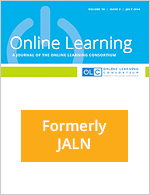Enabling Curriculum Re-design Through Asynchronous Learning Networks
This paper considers existing processes in Higher Education and the opportunity for using Asynchronous Learning Networks (ALNs) to re-design the curriculum. A curriculum model based upon experiential learning, that explicitly links theory and practice, is promoted as the basis for considering the application of technology. The Computer Supported Experiential Learning...

